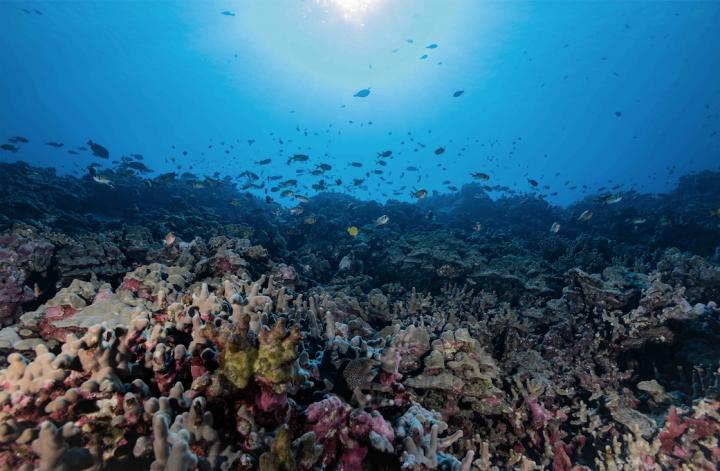
Credit: Greg Asner, Arizona State University Center for Global Discovery and Conservation Science
Resource fishes–species targeted for human consumption–play a key role in reef ecosystems long before they end up on the dinner table. In Hawai?i, subsistence and recreational fishing of local resource fish represent more than half of the share of annual reef seafood consumption, while also playing a vital role in indigenous cultural life.
These same fishes also help reefs to stay healthy by removing algae from coral surfaces, which in turn, help coral recover from bleaching. Given the beneficial relationship between resource fishes and corals, determining how local pressures impact resource fish biomass is necessary for improving reef conservation and management.
In a new study investigating human impacts on resource fish biomass on the Island of Hawai?i, researchers from the Arizona State University Center for Global Discovery and Conservation Science (GDCS) and Hawai’i Division of Aquatic Resources (DAR) observed an alarming 45% decrease in fish biomass over a decade of surveys. The scientists proposed actionable solutions to mitigate future losses. The study was published today in Ecological Applications.
The researchers investigated the influence of local factors on the nearshore resource fisheries of West Hawai’i Island and compared the impact of distinct types of marine protections. They considered a range of factors including commercial and non-commercial fishing as well as nitrogen pollution from sewage disposal systems and golf courses. They also used ASU’s Global Airborne Observatory to map the 3-D reef habitat to assess how it affects fish diversity, abundance, and biomass. The researchers analyzed extensive fish survey data collected by DAR between 2008 and 2018 at more than 300 sites spanning 180 km of coastline.
“Resource fish have been greatly reduced over the past decade in West Hawai’i. We see that negative impacts of nitrogen pollution can outweigh other habitat and land-use stresses on resource fish,” said Dr. Shawna Foo, a postdoctoral researcher at GDCS and lead author of the study. Nitrogen effluent from sewage and golf courses contaminates nearshore waters, creating stress for corals and were a major driver of resource fish declines documented in the study.
Despite the long-term decline, the researchers also found that different types of management resulted in different levels of fish biomass. They found significantly greater fish abundance and biomass in areas that banned spearfishing compared to areas that did not, likely due to the fact that four of the five most common species from the surveys are primarily caught by spears. This finding was particularly true for ?scrapers’ such as parrotfish.
The researchers also found that marine management areas with multiple bans on spearfishing, aquarium collection, and lay nets had the highest overall fish biomass compared to other managed or unmanaged areas, especially for herbivorous fish. Their findings are supported by a recent global analysis of marine management led by the University of Leeds, which reported higher fish biomass in areas where gear was limited to pole and line fishing. Those researchers recommended specific gear restrictions as a relevant management strategy to attain the dual objectives of supporting resource fish biomass recovery and satisfying stakeholders.
Greg Asner, GDCS director and co-author of the study noted, “These results are among the clearest to emerge for Hawai?i. Based on the long-term monitoring efforts of our Hawai?i DAR partners, we were able to ascertain unequivocal evidence for a decline in shallow reef fish populations along the famous Kona coast of Hawai?i Island. We were also able to connect both the decline and the remaining fish stocks to specific actions that can be taken now to enhance the fishery and protect reefs. This is a triple win for science, management, and the fisher community.”
The study reinforces the urgent need to protect reef ecosystems from increasing threats of habitat degradation and climate change. Last year alone, ocean temperatures reached near-record levels, ushering in a coral bleaching event that resulted in coral loss across the Hawaiian archipelago. To protect resource fish biomass and aid reef resilience and recovery, regional management of multiple stressors is greatly needed. The researchers proposed to mitigate such future losses by banning and/or restricting specific fishing gear types and more aggressive management of land-based pollution.
“The collaboration with our partners at GDCS provides an incredible opportunity to combine state-of-the-art seascape level mapping with DAR’s long-term coral reef monitoring to understand the links between marine and land management and coral reef health.”, noted Brian Neilson, Administrator in charge of the Hawai?i Division of Aquatic Resources. “This study is critical for informing statewide management strategies to maintain important resource fish stocks and resilient reefs, as we face unprecedented climate-driven threats.”
###
This study was supported by grants from the Lenfest Ocean Program, The Battery Foundation, and the John D. and Catherine T. MacArthur Foundation.
Media Contact
Heather D’Angelo
[email protected]
Original Source
https:/
Related Journal Article
http://dx.




